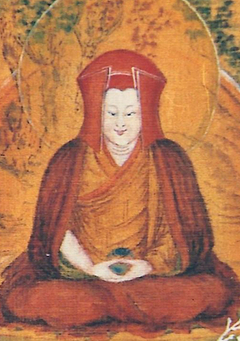A Precious Garland
A Precious Garland for the Supreme Path of the Three Types of Individual: The Root of Dakpo's Four Dharmas
by Gampopa Sonam Rinchen
You never allow vows, commitments and devotion to decline,
And uphold the lineage of scripture, realization and blessings —
To the noble gurus in the lineage of Jowo Atiśa's instructions,
I offer obeisance from my bones and the centre of my heart.
The teachings, which are the subject expressed in all vehicles,
Include the stages of the path for indviduals of the three levels,
The main routes taken by the noble beings of the three times.
These are explained extensively through the four dharmas,
And each is practised through view, meditation and conduct.
With the correct view, to meditate on actions and their effects,
And, as the conduct, to take up virtue and avoid misdeeds,
Resulting in the higher realms of devas and human beings —
This, in summary, is the approach of lesser individuals.
Twofold selflessness as the view, meditation on faults,[1]
And, with renunciation, the conduct of the three trainings,
Resulting in a śrāvaka's or pratyekabuddha's awakening —
This, in summary, is the approach of intermediate individuals.
The two truths as the view, meditation on their union,
And the six transcendent perfections as conduct,
Bringing about the result of unlocated nirvāṇa —
This, in summary, is the approach of great individuals.
Within the space-like expanse of the dharmatā nature,
To use appearances as the means to train in bodhicitta,
Is to turn the two truths into the twofold accumulation,
And this should be known as the cause of the two kāyas.
To be able to give my own happiness to others —
That is the true measure of loving kindness.
To be able to take others' suffering upon myself —
That is the true measure of compassion.
To remain unperturbed by deliberate harm —
That is the true measure of bodhicitta.
Not seeking to gain pleasure and avoid pain —
That is the true measure of the view.
In the nature of my own mind
And the nature of others' minds
There is no dualistic separation,
So how can clinging to self and other be right?
To know the nature of saṃsāra, it is said,
Is also to know the nature of nirvāṇa —
Since this is how it is taught, how can it be right
To cling to saṃsāra and nirvāṇa as good and bad?
When it is taught that to recognize the unity
Of emptiness and interdependence is the path of the Middle Way,
What is the point of requiring a separate guru
Who reveals emptiness?[2]
If you understand the fabrications of your own mind,
Then since everything is lacking in true reality,
No matter how things appear, they become
A support or conducive cause for mind training —
What need is there then for any further elimination of obstacles?
This concludes this text, which was composed by the one prophesied by the Buddha to work for the teachings here in this land of the northern snow mountains when known as Gelong Tsoché.[3]
| Translated by Adam Pearcey, 2018.
Bibliography
Tibetan Source
chos rje sgam po pa. "dwags po chos bzhi'i rtsa ba skyes bu gsum gyi lam gyi mchog rin po che'i 'phreng ba" in blo sbyong gces btus. s.l.: s.n., n.d.
Version: 1.1-20250206
